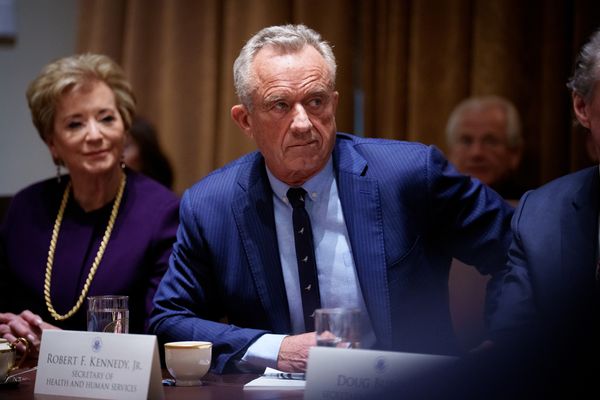Trade sanctions on Russia will have little direct impact on Australian producers, but higher prices will still be felt here, analysts say.
Russia's attacks on Ukraine have seen the global oil price shoot up to levels not seen in years, with grain and other commodity prices also surging.
Analysts say the impact will be felt in different ways in Australia, as the market disruptions ripple through supply chains.
There are estimates average petrol prices could hit $2.10 a litre.
Trade relationship with Russia is minimal
The direct impact on Australian producers is expected to be minimal.
Russia accounts for just 0.1 per cent of Australia's merchandise trade, ranking 42nd on our list of trading partners.
It ranks 29th in value ($723 million) for Australia's merchandise exports.
It ranks 56th in value ($250 million) for merchandise imports to Australia.
Rabobank economist Wouter van Eijkelenburg said because bilateral trade with Russia was so minimal, trade restrictions on Russia would not directly impact Australian producers that much.
When it comes to Australian exports to Russia, in 2019-20 there were $499 million worth of confidential items and special transactions (estimated to include mostly alumina).
But of the goods that were transparent, the largest were live animal exports ($98 million) and fertiliser imports ($71 million), both of which were relatively small.
Major Australian imports from Russia, 2019-20:
- Fertilisers (excluding crude): $71 million
- Crude petroleum: $59 million
- Wood manufactures: $25 million
- Salts of inorganic acids and metals: $17 million
Major Australian exports to Russia, 2019-20:
- Live animals (excluding seafood): $98 million
- Starches, inulin and wheat gluten: $17 million
- Specialised machinery and parts: $9 million
- Meat (excluding beef): $7 million
However, that does not mean there will not be any effect on Australia's economy at all.
Higher prices will still reach here
Mr van Eijkelenburg said Russia was a large exporter of many key commodities globally, including energy, grains, fertiliser, and metals.
The impact of tough trade restrictions on Russia will likely be felt in Australia via higher prices.
But not everyone will lose from the restrictions.
Mr van Eijkelenburg said his economics team had done some scenario analysis that assumed the prices of those key commodities would increase substantially because Russian exports of those commodities would stop or become uncertain.
And those rising prices would lead to "winners" and "losers" in Australia.
"'Winners are producers that benefit from a rise in commodity prices," he said.
"Among others, these are mining companies (iron ore, gas), and wheat and corn producers who are able to benefit from higher prices resulting from reduced supply.
"On the other hand, higher petrol and fertiliser prizes will limit the upside for food and agricultural producers."
He said for the "losers", much of the negative impact would come from "significantly higher" input prices hitting global and local producers.
He said the effects would travel through supply chains and hit Australian consumers indirectly as producers passed on their higher input costs.
As a result, inflation would increase, business investments could decrease, and household purchasing power would deteriorate further.
"All factors limiting economic growth," he said.
However, he also emphasised the high level of uncertainty at the moment, saying it was hard to predict where things could lead.
On Friday morning, Federal Minister for Resources and Water Keith Pitt said Australia's resource sector was currently "thriving".
"Recent requests from Poland to Australia for coal from sources alternative to Russia show the world is increasingly looking to Australia for the resources needed to provide energy security," he said.
What about inflation and interest rates?
The tough trade sanctions on Russia could make the Reserve Bank's job harder by increasing inflationary pressures on the back of higher commodity prices, Mr van Eijkelenburg said.
That would put the RBA in an awkward position, given inflation had already started rising before the conflict began.
"Raising rates will not alleviate the supply shortages, and hence will do little to stem these price pressures," Mr van Eijkelenburg warned.
"However, in the longer run, higher rates would deal a double whammy to growth, considering that demand will also be eroded by higher prices."
He said the RBA would be wise to focus on the developments of fundamentals in the Australian economy to prevent serious policy mistakes.
"The RBA seems to do just that by keeping the cash rate at 0.1 per cent in their March meeting while continuing to signal its patience," he said.
This week, RBA governor Philip Lowe said the RBA board was prepared to be patient as it monitored how the various factors affecting inflation in Australia evolved in coming months.
Petrol prices at $2.10 a litre
Russia supplies about 30 per cent of Europe’s gas and oil imports and accounts for around 11 per cent of world oil production.
So far, the United States and Europe have not imposed sanctions on Russia's energy sector because they want to minimise the damage done to the world's energy system.
However, companies are shunning Russian oil anyway.
At least 10 tankers have recently failed to find buyers for their cargoes of Russian oil, according to reports.
The Oxford Institute for Energy Studies said this "self-sanctioning" was already having an impact on oil supplies, and could eventually add $US25 to the cost of a barrel of Brent crude oil.
"At its peak impact, such a scenario could result in a disruption between 3 million to 4 million barrels a day of Russian crude oil production from current levels of 11 million barrels a day (including condensate)," it said in a new report.
"Looking forward the market focus should not only be on whether the oil sector will be directly targeted by sanctions, but also the crescendo effect of self-sanctioning along the oil supply chain all the way from marketing to financing to shipping.
"It has become clear that traders holding Russian crude on their books are struggling to clear cargoes and this has been reflected in widening differentials and rising shipping and insurance costs."
Australia imports the majority of its refined fuel from Asia, but the hit to the oil supply in Europe will still be felt here.
Some analysts estimate Australian motorists could see petrol prices averaging $2.10 a litre.
According to online aggregator FuelPrice Australia, the average price for 98 Octane currently sits at $2.02 a litre in Sydney, $2.19 in Melbourne, $2.13 in Canberra, and $1.99 in Brisbane.
For Unleaded 91, the average price is currently $1.97 a litre in Hobart, $1.95 in Melbourne, $1.80 in Sydney and $1.78 in Brisbane.







